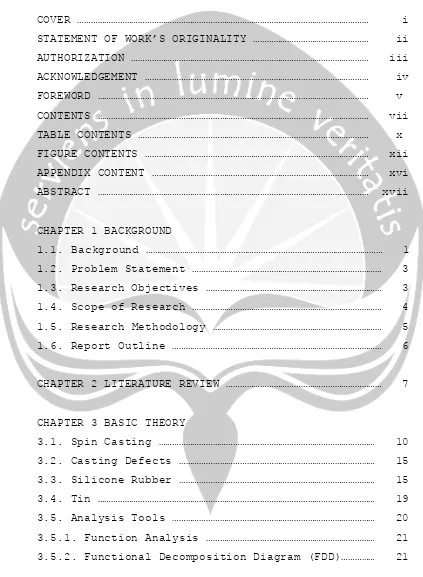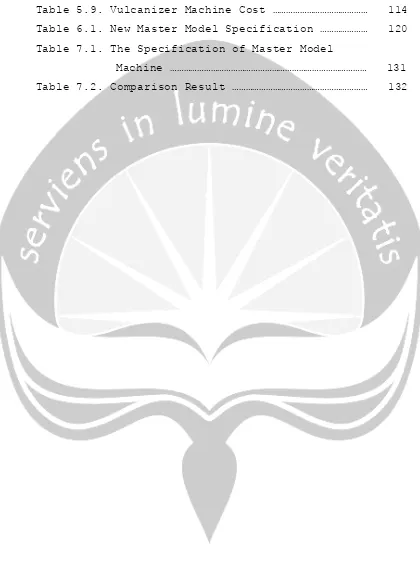i
DEVELOPMENT OF MASTER MODEL MACHINE FOR SPIN
CASTING TECNOLOGY
THESIS
This is Submitted to Fulfill Prerequirement of Industrial Engineer of International S-1 Program
Written by:
Agustinus Mahar Wicaksono 04 14 04299
INTERNATIONAL INDUSTRIAL ENGINEERING PROGRAM INDUSTRIAL TECHNOLOGY FACULTY
ATMA JAYA YOGYAKARTA UNIVERSITY YOGYAKARTA
iv
ACKNOWLEDGMENT
This Thesis is dedicated for
Mom, Dad and My Sisters
v FOREWORD
This final report is one of the prerequisite to
finish the undergraduate study program in Industrial
Engineering Department, Industrial Technology Faculty,
Atmajaya Yogyakarta University.
I am so grateful to many people who encouraged,
and help me to finish this final report. On this
opportunity, I would like to thank:
1. Jesus Christ, for His blessing and guidance.
2. Mr. Ir. B. Kristianto, M.Eng., Ph.D, as the Dean of
Industrial Technology Faculty, Atmajaya Yogyakarta
University.
3. Mr. The Jin Ai, D.Eng., Ph.D, as the Head of
Industrial Engineering Department, Industrial
Technology Faculty, Atmajaya Yogyakarta University.
4. Mrs. Ririn Diar Astanti, D. Eng, as the Coordinator
International Class of Industrial Engineering.
5. Mr. Theodorus B. Hanandoko, S.T., M.T., as first
adviser, who had spent plenty of time to give
guidance, direction, inputs and correction in
writing this final report.
6. Mr. Paulus Wisnu Anggoro, S.T., M.T., thanks for
all those advice, inputs and support in writing
this final report.
7. Mr. Ashari and his crews at Hari Mukti Teknik
Workshop, thank you the input, the idea of machine
construction, and warm welcome.
8. Friends, Dahana, Eko, William, Pieter, for our
quality brainstorming session. Thanks for the
vi
9. My lovely Bebeb. Thanks for your patience. Your
phone calls cheers me up during the completion of
my thesis. Warm kiss. I love you.
10. My friends TIKI Batch 2004, finally, we’re in the
same level. Thank you.
11. My lovely Family, Dad and my sisters, especially
for minister of financial my mom, thanks for your
approval in funding my thesis, love you mom.
12. Uncle hadi, uncle Budi, Mas eko and families at
Fajar Indah Solo for nice advice, support and warm
welcome during the research of silicon rubber.
13. All those who haven’t mentioned, thank you.
I realize that this final report has not perfect
but I hope that this final report can be useful and can
be developed in a further research.
vii
CHAPTER 1 BACKGROUND 1.1. Background ……… 1
CHAPTER 3 BASIC THEORY 3.1. Spin Casting ……… 10
viii
3.5.3. Design Failure Mode Effect Analysis (DFMEA) 26
3.5.4. Grid Analysis ……… 34
3.5.5. Tree Diagram ……… 36
3.5.6. The Cause and Effect Diagram (Fishbone Diagram) ……… 39
3.5.7. Arrow Diagram ……… 41
3.6. Mechanical Design Procedure ……… 43
3.6.1. Shaft Design Procedure ……… 43
3.6.2. Taper Key Design Procedure ……… 51
3.6.3. Axial Bearing Design Procedure ……… 55
3.9. Production Cost ……… 57
CHAPTER 4 COMPANY PROFILE AND DATA 4.1. Current Spin Casting Machine Component Data ……… 69
4.2. Experiment Material Cost……… 76
4.3. Data of Machine component cost ……… 60
CHAPTER 5 ANALYSIS AND DISCUSSION 5.1. Analysis 5.1.1. Analysis using Function Analysis ……… 61
5.1.2. Analysis using Functional Decomposition Diagram ……… 62
5.1.3. Analysis using FMEA ……… 64
5.2. Redesign Process ……… 70
5.2.1. Substitute Material for Hinge (Part A1-3) and (part A1-4) ……… 70
5.2.2. Substitute Material for Upper Inlet (Part B1-1)……… 72
ix
5.2.5. Substitute Bolt M7 to Taper Key as Shaft Stopper
Key ……… 99
5.2.6. Redesigned Head Casting ……… 104
5.2.7. Substitute The Selected Guide Member (Part B2-3)
and Sealing Member (Part B2-6)……… 105
5.2.8. Adjustment Design for pulley (Part B2-5) and
Belt (Part B2-5-1)……… 95
5.3. Result of Redesign Process ……… 96
5.4. The Experimental Analysis of Adaro Business Card
Holder The New Master Model Machine ……… 99
5.4.1. Analysis of The Result on Experiment Adaro
Business Card Holder Using The New Master Model
Machine ……… 100
5.4.2. Analysis Production Cost of Adaro Business Card
Holder ……… 113
5.4.3. Analysis of Master Model Machine Cost ………… 117
5.6.4. Analysis of Production Cost of Adaro Business
Card Holder ……… 118
5.2. Discussion ……… 115
CHAPTER 6 MANUAL INSRTUCTION
6.1. Component Unit of Spin Casting Machine ……… 119
6.2. The List of Specification of Spin Casting
Machine ……… 122
6.3. The Operating Procedure of Spin Casting
Machine ……… 122
CHAPTER 7 CONCLUSION AND SUGGESTION
7.1. Conclusion ……… 135
x
TABLE CONTENTS
Table 2.1. Comparison Previous and Present Research 10
Table 3.1. Properties of Some Silicone Rubber ………… 19
Table 3.2. The Functional Decomposition Elements … 23 Table 3.3. DFMEA Form Table ……… 27
Table 3.4. Severity Rating ……… 29
Table 3.5. Occurrence Rating ……… 31
Table 3.6. Detection Rating ……… 32
Table 3.7. Grid Analysis Table Before Weighted ……… 36
Table 3.8. Grid Analysis Table After Weighted ………… 36
Table 3.9. Correction Factor of Power Transmitted… 46 Table 3.10. The Size of Taper Key ……… 52
Table 3.11. The Allowed Pressure on Axial Bearing … 55 Table 4.1. Current Master Model Machine Specifications ……… 59
Table 4.2. Experiment Material Cost ……… 59
Table 4.3. Data of Component cost ……… 60
Table 5.1. Classification of Critical Functions Parts ……… 64
Table 5.2. FMEA Form ……… 66
Table 5.3. The Result of redesign Process ……… 97
Table 5.4. Usage of HTV Silicon Rubber in Vulcanizer at First Trial ……… 100
Table 5.5. Usage of HTV Silicon rubber in Vulcanizer at Second Trial ……… 108
Table 5.6. Usage of HTV Silicon rubber in Vulcanizer at Third Trial ……… 111
Table 5.7. Production Time Using Master Model Machine ……… 113
xi
Table 5.9. Vulcanizer Machine Cost ……… 114
Table 6.1. New Master Model Specification ……… 120
Table 7.1. The Specification of Master Model
Machine ……… 131
xii
FIGURE CONTENTS
Figure 1.1. Flowchart of Research Methodology ………… 5
Figure 3.1. Arrange Part on the Mold ……… 10
Figure 3.2. Arrange Locknut and Sprayed ……… 11
Figure 3.3. Vulcanization ……… 11
Figure 3.4. Gating and Venting ……… 12
Figure 3.5. Spinning ……… 13
Figure 3.6. Pouring ……… 13
Figure 3.7. Pouring Illustration ……… 14
Figure 3.8. Removal Parts ……… 14
Figure 3.9. Silicone Rubber Chain ……… 16
Figure 3.10. Example of Tree Diagram ……… 39
Figure 3.11. Illustration of Fishbone Diagram ………… 40
Figure 3.12. Example of Arrow Diagram ……… 42
Figure 3.13. Flow Diagram for Shaft with Torsion and Bending Force Design Procedure ……… 45
Figure 3.14. α Stress Concentration Factor of Taper Key ……… 49
Figure 3.15. Shear Stress on Taper Key ……… 52
Figure 3.16. Flow Diagram for Taper Key Design Procedure ……… 54
Figure 3.17. Flow Diagram for Axial Bearing Design Procedure ……… 56
Figure 4.1. Current Master Model Machine ……… 58
xiii
Figure 5.3. The Functional Decomposition Diagram for
The Current Spin Casting Machine ……… 63
Figure 5.4. Hinge Substitute Material Selecting Process ……… 71
Figure 5.5. Mild Steel of Hinge on Top Enclosure……… 72
Figure 5.6. Upper Inlet Substitute Material Selecting Process ……… 73
Figure 5.7. Handle Substitute Material Selecting Process ……… 75
Figure 5.8. Mild Steel on Top Enclosure ……… 76
Figure 5.9. Forces on Shaft ……… 78
Figure 5.10. Forces of Belt Tension ……… 79
Figure 5.11. Forces of Belt Tension Toward Z and X… 80 Figure 5.12. Reaction Forces Toward Z and X ……… 80
Figure 5.13. Reaction Forces Toward X and Y ……… 81
Figure 5.14. Bending Moment Diagram ……… 82
Figure 5.15. The Modified Mold Frame Design of Vulcanizer for Head Casting……… 88
Figure 5.16. Tree Diagram-The Best Design for Head Casting ……… 89
Figure 5.17. Modified Mold Frame-Provide Balance…… 90
Figure 5.18. Modified Mold Frame-Minimum Silicon Rubber Usage ……… 91
Figure 5.19. Counter-Grip Position ……… 92
Figure 5.20. Illustration of Complete Head casting … 92 Figure 5.21. UCF four Flanged Bearing ……… 94
Figure 5.22. The Adaro Business Card Holder Product Master ……… 99
Figure 5.23. Figure of Tin Use ……… 100
xiv
Figure 5.25. Result Of Spin Casting Process on First
Trial ……… 102
Figure 5.26. Fishbone Diagram for Penetration Defect ……… 103
Figure 5.27. Tree Diagram for the Best Mold Frame Design Related on Shrinkage at the Rubber Mold ……… 104
Figure 5.28. Dimesion Gap because of Shrinkage on silicon Rubber Mold ……… 105
Figure 5.29. Result of Spin Casting Process at 34mm Height ……… 106
Figure 5.30. Figure of Tin Selection ……… 106
Figure 5.31. Result of Spin Casting Process Using 50% Tin in First Trial ……… 107
Figure 5.32. Overview after Vulcanizing on Second Trial ……… 109
Figure 5.33. Result of Spin Casting Process on Second Trial ……… 109
Figure 5.34. Fishbone Diagram for Penetration Defect ……… 110
Figure 5.35. The New Dimension of New Mold Frame … 111 Figure 5.36. Result of Spin Casting Process Using 50% Tin at Third Trial ……… 112
Figure 5.37. Arrow Diagram of Casting Process ……… 113
Figure 6.1. New Master Model Machine ……… 121
Figure 6.2. Thermocouple Setting ……… 121
Figure 6.3. MCB Turning On ……… 121
Figure 6.4. Cutting HTV Silicon Rubber ……… 121
Figure 6.5. Scaling Rubber ……… 122
xv
Figure 6.7. Set Silicon Rubber With Master Product,
Sprue and Locknuts ……… 123
Figure 6.8. Lubrication at Silicon Rubber ……… 123
Figure 6.9. Install the Upper Mold Frame ……… 124
Figure 6.10. Turning Handle ……… 124
Figure 6.11. Inserting the Mold Frame ……… 124
Figure 6.12. Pressing the Mold Frame ……… 125
Figure 6.13. MCB Turning Off ……… 125
Figure 6.14. Pulling Out the Mold Frame ……… 125
Figure 6.15. Open the Mold Frame ……… 126
Figure 6.16. Open Top Enclosure ……… 127
Figure 6.17. Load Silicon Rubber……… 127
Figure 6.18. Fasten the Mold Frame ……… 127
Figure 6.19. Close Top Enclosure ……… 128
Figure 6.20. Connect Electrical Plug to the jack … 128 Figure 6.21. Turn the Switch On ……… 128
Figure 6.22. Pour the Molten Metal……… 129
Figure 6.23. Turn the Switch off ……… 129
Figure 6.24. Open Top Enclosure ……… 129
Figure 6.25. Remove Mold Frame ……… 130
xvi
APPENDIX CONTENTS
xvii ABSTRACT
A master model is required before a product is actually processed in a machine. A present research build a prototype of master model machine in spin casting technology which is not reliable for production process.
The present master model machine was evaluated and redesigned focused on the need of larger mold frame and eliminate prop usage to enhance the reliability of producing good quality of master product souvenirs made from tin. The evaluation was started by constructing Functional Decomposition Diagram. Later, the decomposed part list was classified to its critical function based on Function Analysis. Failure Modes Effects Analysis (FMEA) was performed to evaluate failures of current machine. Those failures were become input for redesign process. Mechanical Design Procedure, Grid Analysis, and Tree Diagram were performed during redesign process. Some defects were found during experimental works of Adaro business card holder using the new master model machine. The Cause and Effect Diagram was performed to find best solution to solve related problems.
By the end of the research, master model machine with dimension 530mm x 440mm x 710mm; operating speed at 460 rpm; maximum silicone rubber dimension 204mm x 178mm x 36mm ; electricity power 373 W and Adaro business card holder product were obtained. The production time is 11, 15 minutes and the production cost per unit is IDR 10,500.00.

